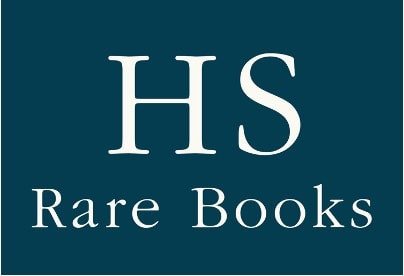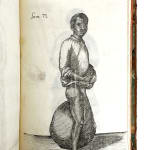![[Cuba; natural history] Antonio Parra, Descripción de diferentes piezas de Historia Natural de las mas del ramo marítimo representadas en setenta y cinco láminas, 1787. Habana. Imprenta de la Capitania General.](https://artlogic-res.cloudinary.com/w_1600,h_1600,c_limit,f_auto,fl_lossy,q_auto/artlogicstorage/hsrarebooks/images/view/402d56ff0f08777beb1678d496abcec2j/hsrarebooks-cuba-natural-history-antonio-parra-descripci-n-de-diferentes-piezas-de-historia-natural-de-las-mas-del-ramo-mar-timo-representadas-en-setenta-y-cinco-l-minas-1787.-haba.jpg)
![[Cuba; natural history] Antonio Parra, Descripción de diferentes piezas de Historia Natural de las mas del ramo marítimo representadas en setenta y cinco láminas, 1787. Habana. Imprenta de la Capitania General.](https://artlogic-res.cloudinary.com/w_1600,h_1600,c_limit,f_auto,fl_lossy,q_auto/artlogicstorage/hsrarebooks/images/view/059bfc065a36ac867ed2fdc0f75e53fbj/hsrarebooks-cuba-natural-history-antonio-parra-descripci-n-de-diferentes-piezas-de-historia-natural-de-las-mas-del-ramo-mar-timo-representadas-en-setenta-y-cinco-l-minas-1787.-haba.jpg)
![[Cuba; natural history] Antonio Parra, Descripción de diferentes piezas de Historia Natural de las mas del ramo marítimo representadas en setenta y cinco láminas, 1787. Habana. Imprenta de la Capitania General.](https://artlogic-res.cloudinary.com/w_1600,h_1600,c_limit,f_auto,fl_lossy,q_auto/artlogicstorage/hsrarebooks/images/view/bef150a4f776863f1018aca70a135a49j/hsrarebooks-cuba-natural-history-antonio-parra-descripci-n-de-diferentes-piezas-de-historia-natural-de-las-mas-del-ramo-mar-timo-representadas-en-setenta-y-cinco-l-minas-1787.-haba.jpg)
![[Cuba; natural history] Antonio Parra, Descripción de diferentes piezas de Historia Natural de las mas del ramo marítimo representadas en setenta y cinco láminas, 1787. Habana. Imprenta de la Capitania General.](https://artlogic-res.cloudinary.com/w_1600,h_1600,c_limit,f_auto,fl_lossy,q_auto/artlogicstorage/hsrarebooks/images/view/e567c10a1e08027a0aece70c3510a192j/hsrarebooks-cuba-natural-history-antonio-parra-descripci-n-de-diferentes-piezas-de-historia-natural-de-las-mas-del-ramo-mar-timo-representadas-en-setenta-y-cinco-l-minas-1787.-haba.jpg)
![[Cuba; natural history] Antonio Parra, Descripción de diferentes piezas de Historia Natural de las mas del ramo marítimo representadas en setenta y cinco láminas, 1787. Habana. Imprenta de la Capitania General.](https://artlogic-res.cloudinary.com/w_1600,h_1600,c_limit,f_auto,fl_lossy,q_auto/artlogicstorage/hsrarebooks/images/view/9bd8330f3741134a1f6382f4920b9aa1j/hsrarebooks-cuba-natural-history-antonio-parra-descripci-n-de-diferentes-piezas-de-historia-natural-de-las-mas-del-ramo-mar-timo-representadas-en-setenta-y-cinco-l-minas-1787.-haba.jpg)
![[Cuba; natural history] Antonio Parra, Descripción de diferentes piezas de Historia Natural de las mas del ramo marítimo representadas en setenta y cinco láminas, 1787. Habana. Imprenta de la Capitania General.](https://artlogic-res.cloudinary.com/w_1600,h_1600,c_limit,f_auto,fl_lossy,q_auto/artlogicstorage/hsrarebooks/images/view/3d7244eeae6bd8e0e092585534e46bf2j/hsrarebooks-cuba-natural-history-antonio-parra-descripci-n-de-diferentes-piezas-de-historia-natural-de-las-mas-del-ramo-mar-timo-representadas-en-setenta-y-cinco-l-minas-1787.-haba.jpg)
[Cuba; natural history] Antonio Parra
First edition, the first scientific book published in Havana, the first book on natural history printed in Havana, the first illustrated books published in Havana with plates made by a Cuban-born artist, and certainly the most profusely illustrated at that time, here housed in the contemporary Cuban binding and in exceptional condition.
Further images
4to, (198 x 143 mm). 1 [blank], 1 ff., 4 pp., 195 pp., 3 ff., 75 plates, 2 of which are folded; plate seven bound upside down. Contemporary calf, probably a Cuban binding, spine flat, tooled in gilt, a little rubbed. Excellent example, very clean and fresh, plate 7 bound upside down, light scattered foxing spots, very fresh and clean.
“The book’s plates account for nearly one half of the island’s production of printed images in the eighteenth century” (Princeton´s catalogue entry).
“One of the earliest specimens of printing in Havana, and contains the first copper-plates engraved in Cuba” (Sabin).
The 75 full page plates are made by Parra’s son, Manuel Antonio Parra y Munoz, born in Cuba, and represent fishes, crustacea, geology and human deformities, specifically a black slave with a hernia, he has recently been identified as Domingo Fernandez, and is one of the first Caribbean slaves to be portrayed in a printed source. The 75 plates are a substantial portion of the engravings published in Havana in the 18th century, and are certainly the most beautiful ones.
Little is known before Parra’s voyage to Cuba, except that he enlisted in the Spanish Army and that he travelled to Cuba in 1763 under the command of Funes de Villalpando for the return of the Island to Spanish control from the English, following the Treaty of Versailles in which Florida was given to England. His naturalist labor in the country led him to build a collection of natural history -namely- marine specimens collected by him, which he exhibited in Havana in custom made furniture; his collection was later partially acquired by the King of Spain following the author’s trip to Spain (1788) to present this book, and the recommendation of the Director of the Gabinete de Historia Natural of Madrid, Jose Clavijo. The plates have no scientific names, probably a consequence of Parra’s lack of academic training as naturalist. Parra continued to collect and send seeds to Madrid and Aranjuez in the 1790’s.
“[S]e considera hoy como el primer trabajo cientifico publicado en la isla. Antonio Parra acopiaba piezas de fosiles, moluscos y peces secos que encontraba a la orilla del mar, y las trasladaba a su domicilio con la ayuda de un criado, construyendo asi la colección que luego presentaría al publico bajo la forma de libro de exhibición publica. Para el trabajo de ilustración grafica de la obra, Parra recurrio a la valiosa colaboración de su hijo de dieciséis años, quien se hizo cargo del grabado de las laminas y de las investigaciones y lecturas que requeria su efectuación técnica… [Parra] mando a construir muebles de caoba ´trabajadas al estilo del pais´ para exponer su colección, habiendo consultado ´a varios maestros carpinteros´. Parra escribirá luego a la corte de España señalando que acopiaba ejemplares de especies en cajas de caoba” Jorge Pavez Ojeda, Lecturas de un códice afrocubano. Naturalismo, etiopismo y universalismo en el libro de José Antonio Aponte (La Habana, Circa 1760-1812), Revista del departamento de Historia de la Facultad de Ciencias Sociales de la Universidad de los Andes, Septiembre – Diciembre 2011).
“Antonio Parra, de cuya vida se tienen pocos datos (se desconoce, por ejemplo, la fecha de su muerte), era un portugués nacido en 1739 en Tavira y establecido en La Habana alrededor de 1763 que había iniciado una colección de «producciones naturales» de Cuba. Dávila le envió una carta el 3 de septiembre de 1778, de la que el destinatario acusó recibo en su contestación desde La Habana en marzo de 1779. El interés inicial de Parra era la ictiofauna pero, a instancias de Dávila, comenzó a recolectar también crustáceos decápodos, esponjas y corales.” (Almazán, Javier Ignacio. (2017). La colección histórica de esponjas del Museo Nacional de Ciencias Naturales (MNCN.CSIC): 1771–1939. Graellsia. 73. 060. 10.3989/graellsia.2017.v73.181.)
The work ends with a description of the medical case of a black African from Congo named Domingo Fernandez, illustrated with 3 plates.
Palau, 213307; Sabin, 58835.
Join our mailing list
* denotes required fields
We will process the personal data you have supplied in accordance with our privacy policy (available on request). You can unsubscribe or change your preferences at any time by clicking the link in our emails.






